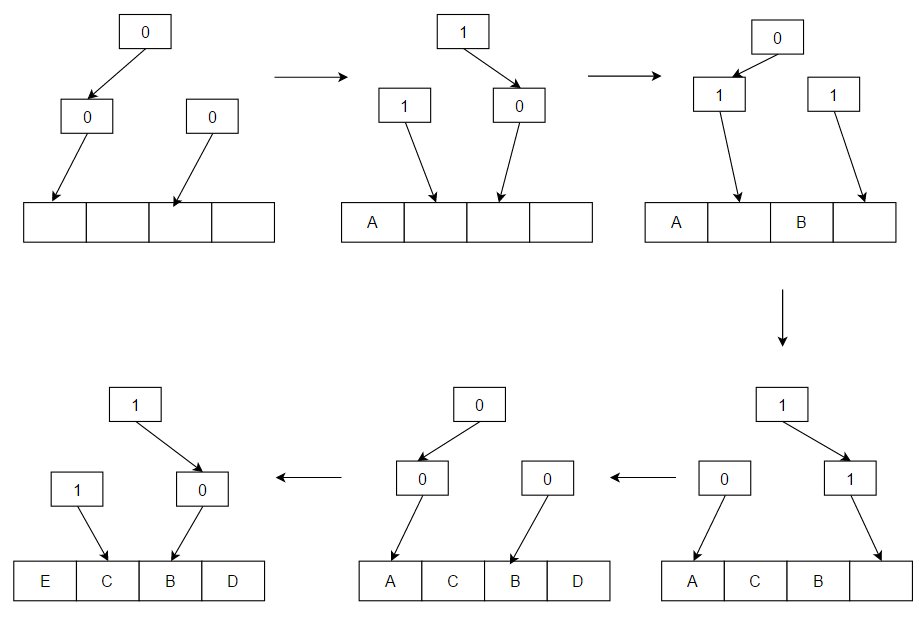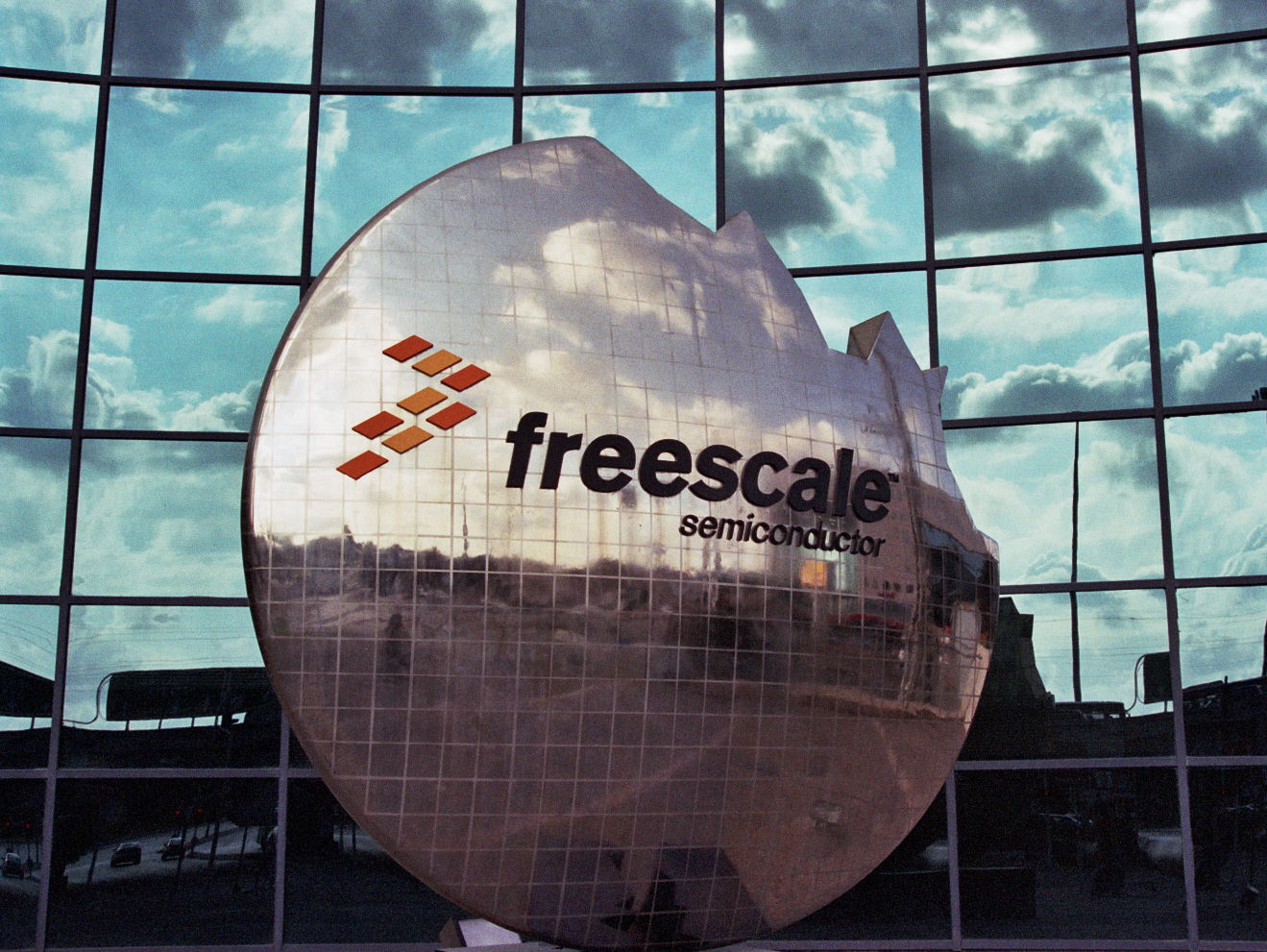|
Pseudo-LRU
Pseudo-LRU or PLRU is a family of cache algorithms which improve on the performance of the Least Recently Used (LRU) algorithm by replacing values using approximate measures of age rather than maintaining the exact age of every value in the cache. PLRU usually refers to two cache replacement algorithms: tree-PLRU and bit-PLRU. Tree-PLRU Tree-PLRU is an efficient algorithm to select an item that most likely has not been accessed very recently, given a set of items and a sequence of access events to the items. This technique is used in the CPU cache of the Intel 486 and in many processors in the PowerPC family, such as Freescale's PowerPC G4 used by Apple Computer. The algorithm works as follows: consider a binary search tree for the items in question. Each node of the tree has a one-bit flag denoting "go left to insert a pseudo-LRU element" or "go right to insert a pseudo-LRU element". To find a pseudo-LRU element, traverse the tree according to the values of the flags. To u ... [...More Info...] [...Related Items...] OR: [Wikipedia] [Google] [Baidu] |
Cache Algorithms
In computing, cache algorithms (also frequently called cache replacement algorithms or cache replacement policies) are optimizing instructions, or algorithms, that a computer program or a hardware-maintained structure can utilize in order to manage a cache of information stored on the computer. Caching improves performance by keeping recent or often-used data items in memory locations that are faster or computationally cheaper to access than normal memory stores. When the cache is full, the algorithm must choose which items to discard to make room for the new ones. Overview The average memory reference time is : T = m \times T_m + T_h + E where : m = miss ratio = 1 - (hit ratio) : T_m = time to make a main memory access when there is a miss (or, with multi-level cache, average memory reference time for the next-lower cache) : T_h= the latency: the time to reference the cache (should be the same for hits and misses) : E = various secondary effects, such as queuing effects in ... [...More Info...] [...Related Items...] OR: [Wikipedia] [Google] [Baidu] |
Algorithm
In mathematics and computer science, an algorithm () is a finite sequence of rigorous instructions, typically used to solve a class of specific problems or to perform a computation. Algorithms are used as specifications for performing calculations and data processing. More advanced algorithms can perform automated deductions (referred to as automated reasoning) and use mathematical and logical tests to divert the code execution through various routes (referred to as automated decision-making). Using human characteristics as descriptors of machines in metaphorical ways was already practiced by Alan Turing with terms such as "memory", "search" and "stimulus". In contrast, a heuristic is an approach to problem solving that may not be fully specified or may not guarantee correct or optimal results, especially in problem domains where there is no well-defined correct or optimal result. As an effective method, an algorithm can be expressed within a finite amount of spac ... [...More Info...] [...Related Items...] OR: [Wikipedia] [Google] [Baidu] |
CPU Cache
A CPU cache is a hardware cache used by the central processing unit (CPU) of a computer to reduce the average cost (time or energy) to access data from the main memory. A cache is a smaller, faster memory, located closer to a processor core, which stores copies of the data from frequently used main memory locations. Most CPUs have a hierarchy of multiple cache levels (L1, L2, often L3, and rarely even L4), with different instruction-specific and data-specific caches at level 1. The cache memory is typically implemented with static random-access memory (SRAM), in modern CPUs by far the largest part of them by chip area, but SRAM is not always used for all levels (of I- or D-cache), or even any level, sometimes some latter or all levels are implemented with eDRAM. Other types of caches exist (that are not counted towards the "cache size" of the most important caches mentioned above), such as the translation lookaside buffer (TLB) which is part of the memory management unit ... [...More Info...] [...Related Items...] OR: [Wikipedia] [Google] [Baidu] |
Intel 486
The Intel 486, officially named i486 and also known as 80486, is a microprocessor. It is a higher-performance follow-up to the Intel 386. The i486 was introduced in 1989. It represents the fourth generation of binary compatible CPUs following the 8086 of 1978, the Intel 80286 of 1982, and 1985's i386. It was the first tightly- pipelined x86 design as well as the first x86 chip to include more than one million transistors. It offered a large on-chip cache and an integrated floating-point unit. A typical 50 MHz i486 executes around 40 million instructions per second (MIPS), reaching 50 MIPS peak performance. It is approximately twice as fast as the i386 or i286 per clock cycle. The i486's improved performance is thanks to its five-stage pipeline with all stages bound to a single cycle. The enhanced FPU unit on the chip was significantly faster than the i387 FPU per cycle. The intel 80387 FPU ("i387") was a separate, optional math coprocessor that was installed i ... [...More Info...] [...Related Items...] OR: [Wikipedia] [Google] [Baidu] |
PowerPC
PowerPC (with the backronym Performance Optimization With Enhanced RISC – Performance Computing, sometimes abbreviated as PPC) is a reduced instruction set computer (RISC) instruction set architecture (ISA) created by the 1991 Apple– IBM–Motorola alliance, known as AIM. PowerPC, as an evolving instruction set, has been named Power ISA since 2006, while the old name lives on as a trademark for some implementations of Power Architecture–based processors. PowerPC was the cornerstone of AIM's PReP and Common Hardware Reference Platform (CHRP) initiatives in the 1990s. Originally intended for personal computers, the architecture is well known for being used by Apple's Power Macintosh, PowerBook, iMac, iBook, eMac, Mac Mini, and Xserve lines from 1994 until 2005, when Apple migrated to Intel's x86. It has since become a niche in personal computers, but remains popular for embedded and high-performance processors. Its use in 7th generation of video game consol ... [...More Info...] [...Related Items...] OR: [Wikipedia] [Google] [Baidu] |
Freescale
Freescale Semiconductor, Inc. was an American semiconductor manufacturer. It was created by the divestiture of the Semiconductor Products Sector of Motorola in 2004. Freescale focused their integrated circuit products on the automotive, embedded and communications markets. It was bought by a private investor group in 2006, and subsequently merged into NXP Semiconductors in 2015. History As of 2003, Motorola Semiconductor Products Sector earned US$5.0 billion in semiconductor sales in 2002 (out of US$27 billion sales for all of Motorola). Motorola announced that their semiconductor division would be divested on October 6, 2003, to create Freescale. Freescale completed its Initial public offering (IPO) on July 16, 2004, at a price of US$13. In its announcement, it estimated the stock price to be US$17.50- 19.50 but following a cooling of the market towards tech stocks, it lowered its price to US$13. Existing shareholders of Motorola stock received 0.110415 shares of Freescale ... [...More Info...] [...Related Items...] OR: [Wikipedia] [Google] [Baidu] |
PowerPC G4
PowerPC G4 is a designation formerly used by Apple and Eyetech to describe a ''fourth generation'' of 32-bit PowerPC microprocessors. Apple has applied this name to various (though closely related) processor models from Freescale, a former part of Motorola. Motorola and Freescale's proper name of this family of processors is PowerPC 74xx. Macintosh computers such as the PowerBook G4 and iBook G4 laptops and the Power Mac G4 and Power Mac G4 Cube desktops all took their name from the processor. PowerPC G4 processors were also used in the eMac, first-generation Xserves, first-generation Mac Minis, and the iMac G4 before the introduction of the PowerPC 970. Apple completely phased out the G4 series for desktop models after it selected the 64-bit IBM-produced PowerPC 970 processor as the basis for its PowerPC G5 series. The last desktop model that used the G4 was the Mac Mini which now comes with an Apple M1 processor. The last portable to use the G4 was the iBook G4 but w ... [...More Info...] [...Related Items...] OR: [Wikipedia] [Google] [Baidu] |
Apple Computer
Apple Inc. is an American multinational technology company headquartered in Cupertino, California, United States. Apple is the largest technology company by revenue (totaling in 2021) and, as of June 2022, is the world's biggest company by market capitalization, the fourth-largest personal computer vendor by unit sales and second-largest mobile phone manufacturer. It is one of the Big Five American information technology companies, alongside Alphabet, Amazon, Meta, and Microsoft. Apple was founded as Apple Computer Company on April 1, 1976, by Steve Wozniak, Steve Jobs and Ronald Wayne to develop and sell Wozniak's Apple I personal computer. It was incorporated by Jobs and Wozniak as Apple Computer, Inc. in 1977 and the company's next computer, the Apple II, became a best seller and one of the first mass-produced microcomputers. Apple went public in 1980 to instant financial success. The company developed computers featuring innovative graphical user interface ... [...More Info...] [...Related Items...] OR: [Wikipedia] [Google] [Baidu] |
Binary Search Tree
In computer science, a binary search tree (BST), also called an ordered or sorted binary tree, is a rooted binary tree data structure with the key of each internal node being greater than all the keys in the respective node's left subtree and less than the ones in its right subtree. The time complexity of operations on the binary search tree is directly proportional to the height of the tree. Binary search trees allow binary search for fast lookup, addition, and removal of data items. Since the nodes in a BST are laid out so that each comparison skips about half of the remaining tree, the lookup performance is proportional to that of binary logarithm. BSTs were devised in the 1960s for the problem of efficient storage of labeled data and are attributed to Conway Berners-Lee and David Wheeler. The performance of a binary search tree is dependent on the order of insertion of the nodes into the tree since arbitrary insertions may lead to degeneracy; several variations of th ... [...More Info...] [...Related Items...] OR: [Wikipedia] [Google] [Baidu] |







